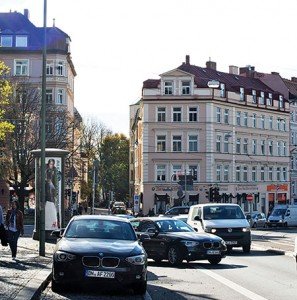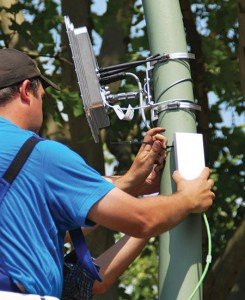 Parking is a problem in major cities. There simply are not enough parking spaces. Now, Siemens has developed a system that will help future drivers find parking spots quickly and without stress. Last year, Siemens and partners launched the world’s first pilot project on intelligent search for parking space in Berlin.
Parking is a problem in major cities. There simply are not enough parking spaces. Now, Siemens has developed a system that will help future drivers find parking spots quickly and without stress. Last year, Siemens and partners launched the world’s first pilot project on intelligent search for parking space in Berlin.
On average, finding a parking place in a German city requires about 4.5 kilometers of extra driving. According to the German Federal Motor Transport Authority, a typical car emitting around 140 grams of CO2 per kilometer will generate at least 630 grams of unnecessary CO2 in the process of looking for a parking space. And significantly more in stop-and-go traffic.
A scarcity of parking spaces has many negative consequences: exhaust fumes and particulates in the air, noise, and the frazzled nerves of frustrated drivers. “Depending on a city’s size, vehicles looking for parking spots account for about 30 percent of its total traffic volume,” says Marcus Zwick, who heads a project that is developing smart parking space monitoring in Siemens’ Mobility Division.
 Siemens and its partners have developed a radar sensor system that offers drivers a quick, hassle-free way to find vacant parking spaces in the urban jungle. An initial pilot project has already been installed for test and demonstration purposes on the Bundesallee in Berlin. The pilot installation is part of the federally funded City2e 2.0 project in which Siemens is exploring the potential of sensor-controlled management systems for roadside parking and electric recharging points in cooperation with the Senate Department for Urban Development and the Environment in Berlin (SenStadtUm), the VMZ Berlin Betreibergesellschaft mbH, the Institute for Climate Protection, Energy and Mobility (IKEM) and the Robotics Innovation Center of the German Research Center for Artificial Intelligence (DFKI).
Siemens and its partners have developed a radar sensor system that offers drivers a quick, hassle-free way to find vacant parking spaces in the urban jungle. An initial pilot project has already been installed for test and demonstration purposes on the Bundesallee in Berlin. The pilot installation is part of the federally funded City2e 2.0 project in which Siemens is exploring the potential of sensor-controlled management systems for roadside parking and electric recharging points in cooperation with the Senate Department for Urban Development and the Environment in Berlin (SenStadtUm), the VMZ Berlin Betreibergesellschaft mbH, the Institute for Climate Protection, Energy and Mobility (IKEM) and the Robotics Innovation Center of the German Research Center for Artificial Intelligence (DFKI).
Intelligent search for parking spaces in Berlin
- The sensor circuits, which are about the size of an adult’s fist, send microwaves towards a predefined surface; any obstacles in their path reflect the waves back to the sensor. Thus the sensor can use a sophisticated algorithm to calculate if and in what position an object is parked in the space, and how big it is.
- The sensor comprises an antenna, analog electronics, an analogto-digital converter and a signal processing component. The sensor is small, which means it can be built in to the lamp fixture on a street light; this also ensures it can be supplied with electricity. Alternatively, the sensors can be fitted to the lamp post or the wall of a building. They can survey from above a cone-shaped area of around 30 by 9 meters: that’s equivalent to between five and seven cars parked in a line.
- Mobile radio signals are used to transmit the measurement data to Berlin’s traffic management control center. The center processes data and prepares it in an accessible format, calculating which parking spaces are full, in real time. Drivers can then use their smartphone or navigation device to enter a destination and receive information on whether and where parking spaces are available nearby.
- The software works with adaptive systems. It recognizes identical recurring cycles in the parking situation – for example if it comes under particular pressure, or much less pressure, at certain times of day or on certain days of the week. The software then predicts for particular road users what the parking situation is likely to be when they reach their destination.
City2.e 2.0: A joint project involving five project partners
 The City2.e 2.0 project funded by the German Federal Ministry for the Environment, Nature Conservation, Building and Nuclear Safety (BMUB) is designed to provide a practical demonstration of integrating parking spaces with recharging points into an intelligent parking space management system. It aims to create a ‘virtual car park’ so it can investigate the relevant requirements. A wide variety of data will be linked together in order to predict and control, with a degree of certainty, traffic looking for a place to park. This includes data from parking space sensors in public or semi-public areas, information
The City2.e 2.0 project funded by the German Federal Ministry for the Environment, Nature Conservation, Building and Nuclear Safety (BMUB) is designed to provide a practical demonstration of integrating parking spaces with recharging points into an intelligent parking space management system. It aims to create a ‘virtual car park’ so it can investigate the relevant requirements. A wide variety of data will be linked together in order to predict and control, with a degree of certainty, traffic looking for a place to park. This includes data from parking space sensors in public or semi-public areas, information
on the occupancy of recharging points, and weather information. The project focuses on coordinating and controlling the traffic so vehicles can travel directly to a vacant parking space or recharging point.
Monitoring Parking Areas
To equip stretches of a street with radar sensors for monitoring parking spaces, cities can use their streetlights as masts. It does not require expensive or new infrastructure for installation. Again, the individual road users’ right to privacy is safeguarded. These radar sensors are much less sensitive to fog, rain, changing light conditions, and winter weather, and they are more economical than ground sensors.
Simple Mounting on Streetlights
Because the sensors are so small, they can be installed in streetlights, where they can be supplied with electricity. They can also be mounted on lampposts or building walls. They can monitor an area measuring approximately 30 meters by nine meters, which corresponds to about five to seven cars parked in a row. Unlike cameras and ultrasound sensors, a radar sensor can be protected by covering it with a plastic casing without disturbing the radar beams. The sensor thus remains invisible within its urban surroundings.
Much more than Parking Management
The system can do a lot more than simply optimizing the parking situation. Sensors could conceivably have additional functions, such as measuring traffic flow, optimizing autonomous vehicle navigation, or informing drivers of electric cars regarding charging station services. It would also be possible to transmit information about traffic density to control centers for a city’s street lighting system. The centers could then adjust lighting to fluctuating traffic needs.
 TrafficInfraTech Magazine Linking People Places & Progress
TrafficInfraTech Magazine Linking People Places & Progress